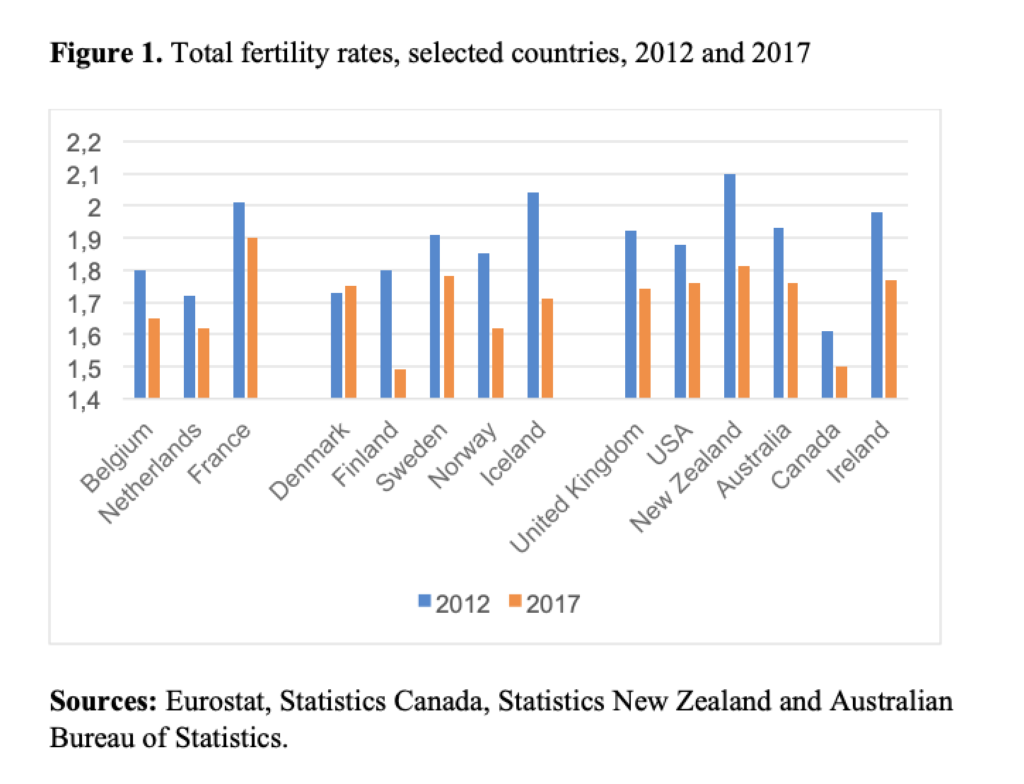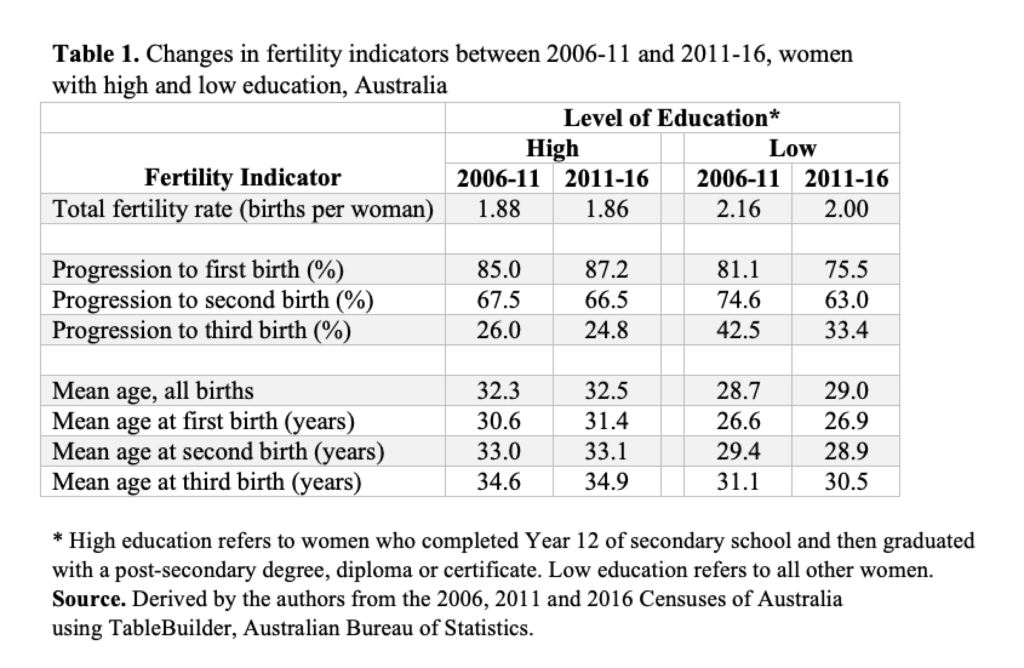In Australia fertility is falling only for low educated women

From 2006 to 2016, fertility in Australia remained constant for women with high education while it fell sharply for women with low education. As in the Nordic countries, Peter McDonald and Helen Moyle observe, this trend may reflect the increasingly regressive nature of government support for families with children.
Background
A well-known feature of fertility rates in OECD countries is the persistent bifurcation between countries with very low fertility (under 1.5 births per woman) and those with ‘moderately’ low fertility, between 1.5 and 2.1 births per woman. The very low fertility group includes all the Southern European, German-speaking and wealthy East Asian countries. The moderately low grouping includes all the Nordic, English-speaking and French-Dutch speaking countries (McDonald 2006, Rindfuss et al. 2016). The conventional interpretation of this bifurcation is that the moderately low fertility countries provide higher levels of support to enable women to combine work and family than those with very low fertility (McDonald 2006, Greulich et al. 2018).
In recent years, however, fertility has fallen in all the moderately low fertility countries except Denmark and some of the falls have been substantial. For example, between 2012 and 2017, the total fertility rate (TFR, births per woman) fell from 1.80 to 1.49 in Finland, from 1.85 to 1.62 in Norway, from 2.04 to 1.71 in Iceland, and from 1.92 to 1.74 in the United Kingdom. In New Zealand, the TFR dropped from 2.0 in 2012 to 1.71 in 2018 (Figure 1), and it stood at 1.73 in the United States in 2018 (US Department of Health and Human Services 2019). At the same time, fertility has remained very low in most of the very low fertility countries, although the rate in Germany rose from 1.41 in 2012 to 1.57 in 2017.

A recent N-IUSSP paper addressing the fall in fertility rates in the Nordic countries (Jalovaara, Neyer and Anderson 2019) observed that it was more apparent among lower educated persons than among the higher educated. The authors concluded that support for the combination of work and family may have underpinned the fertility of higher educated women but was less valuable to others. As this pattern was not evident elsewhere in Europe, they concluded that it was unique to the Nordic countries.
While birth rates by education are difficult to obtain in many countries, very substantial falls in rates of teenage birth in the English-speaking countries suggest that change is taking place among women with lower levels of education because it is these women who had high rates of teenage childbearing in the past. For example, in the United States, the rate of teenage fertility fell from 41 per 1000 in 2008 to 17 per 1000 in 2018 (US Department of Health and Human Services 2019). In Sydney, Australia, it has fallen sharply in the southwestern parts of the city where education levels are low while in the affluent, northern suburbs where education levels are high, teenage fertility cannot fall because it is already close to zero (ABS 2018).
Here, we show that, in Australia, across the two five-year periods, 2006-11 and 2011-16, fertility was near-constant for women with a post Year 12 tertiary qualification (referred to as High Education in the paper and constituting 68% of women aged 30-34, the peak age group of fertility) but fell significantly for those with lower levels of education (the remaining 32%, referred to as Low Education). This result mirrors the situation observed in the Nordic countries.
Australian census: retrospective questions on children ever born
Australia conducts a population census every five years. For the three censuses, 2006, 2011 and 2016, a question on the number of children ever born to a woman was asked. Using the census product, TableBuilder, we were able to produce tables showing the mean number of children born to women and the parity distributions of women by single years of age at the three censuses for the two education categories. From these data, we obtained the changes over the two five-year intercensal periods in mean parity and in the proportions with zero, one, two and three children for single year of age birth cohorts. These changes can then be cumulated across all ages to estimate the total fertility rate and the parity progression ratios that applied in the two five-year periods, 2006-11 and 2011-16.
As women may shift from low to high education levels between ages 15 and 49, we conducted an extensive analysis to determine whether the results were affected by changes in education between the two censuses. We found the effects to be very slight, however, as at relatively high ages, where fertility is not negligible, the difference in fertility between the (small number) of women who increased their education in the intercensal period and those who already had the higher level of education at the previous census was very small. We were able to verify this via the longitudinal census files which match the records of the same individuals across censuses, and through sensitivity analysis.
Fertility decline is stronger for the low educated
Across the two intercensal periods, the average TFR fell by 0.02 births per woman for women with high education but by 0.16 for women with low education. Likewise, the parity progression ratios changed very little for those with high education across the two periods but fell substantially for all three progressions among women with low education (Table 1). Total fertility for women with low education remained above that of women with high education in the 2011-16 period but the difference between the two groups fell by 50 per cent across the two periods.
Notably, however, the mean ages at each progression changed only modestly for both education groups across the two periods, while the ages at each progression remained very different for the two groups. Thus, the fall in fertility for low educated women was due mainly to cross-sectional falls in fertility at all ages.

Discussion
The socio-economic circumstances of women with high and low education are very different. For example, in 2016, among mothers aged 35-39 years, 25 per cent of those with high education were not employed compared with 42 per cent of those with low education. Strikingly, only 12 per cent of the mothers aged 35-39 with high education were not partnered compared with 26 per cent of those with low education.
The balance of family support policy in Australia today is very much in favour of working women and, hence, more highly educated women. From one perspective, this is an enlightened policy that has enabled educated women to maintain a fertility rate of around 1.8 births per woman while having a high rate of employment. In addition, 75 per cent of women in highly qualified jobs receive paid maternity leave at their salary level from their employers. On top of this, they are entitled to $14,387 in government-funded paid maternity leave, so long as their individual income is below a very high threshold. The children of working women are also entitled to 50 hours per week of government-subsidised child care. As described above, educated employed women with children are also much more likely to be partnered than the low educated and, in most cases, their partners will also be highly educated and well-paid.
While policy has been good for highly educated women, government support for women (and their children) who are not employed (a higher proportion of the low educated) has moved strongly downwards since 2011. They are eligible for a Newborn Upfront Payment but this has fallen from $5,294 for each child in 2011 to $1,650 for the first child and $550 for subsequent children today, levels way below the amount paid to employed women through government-funded maternity leave. In addition, their children are eligible for only 20 hours of childcare per week compared to 50 hours for employed women. And lone mothers whose youngest child has turned six receive the extremely low, Newstart (unemployment) payment whereas previously they received a much higher level of benefit.
Hence, government support for families with children became much more regressive in the second period, 2011-16, than in the first. Thus, as in the Nordic countries, the closing gap between the fertility rates of highly educated and low educated women may well be related to the relatively low level of government support for poorer people.
References
ABS (Australian Bureau of Statistics) (2018). Births, Australia, 2017.
Greulich A, Guergoat-Lariviere M & Thevenon O (2018). Facilitating family enlargement in Europe through dual parental employment. N-IUSSP, May 28.
Jalovaara M, Neyer G & Andersson G (2019). Persistence and reversals in Nordic fertility. N‑IUSSP, April 15.
McDonald P (2006). Low fertility and the state: the efficacy of policy, Population and Development Review, 32(3), 485-510.
Rindfuss R, Choe M-K & Brauner-Otto S (2016) The emergence of two distinct fertility regimes in economically advanced countries. Population Research and Policy Review, 35(3), 287-304.
US Department of Health and Human Services (2019) Births: Provisional Data for 2018, Vital Statistics Rapid Release, Report No. 007, May 2019.